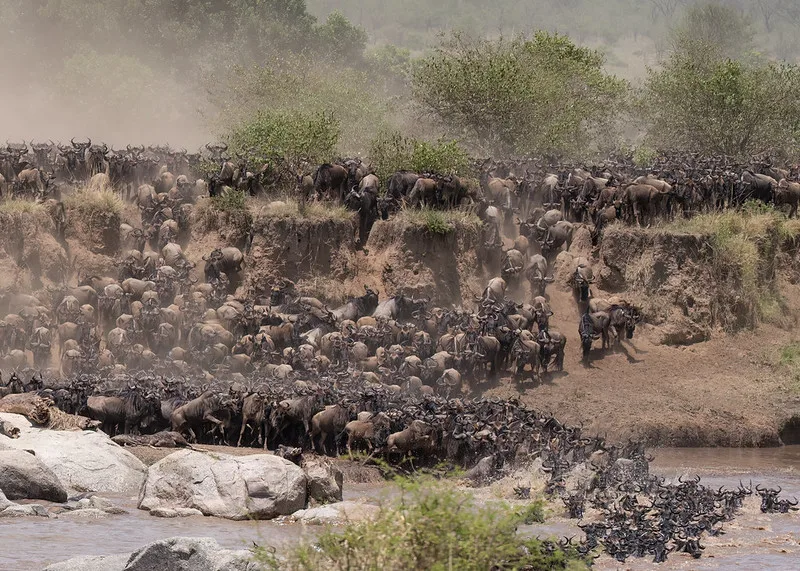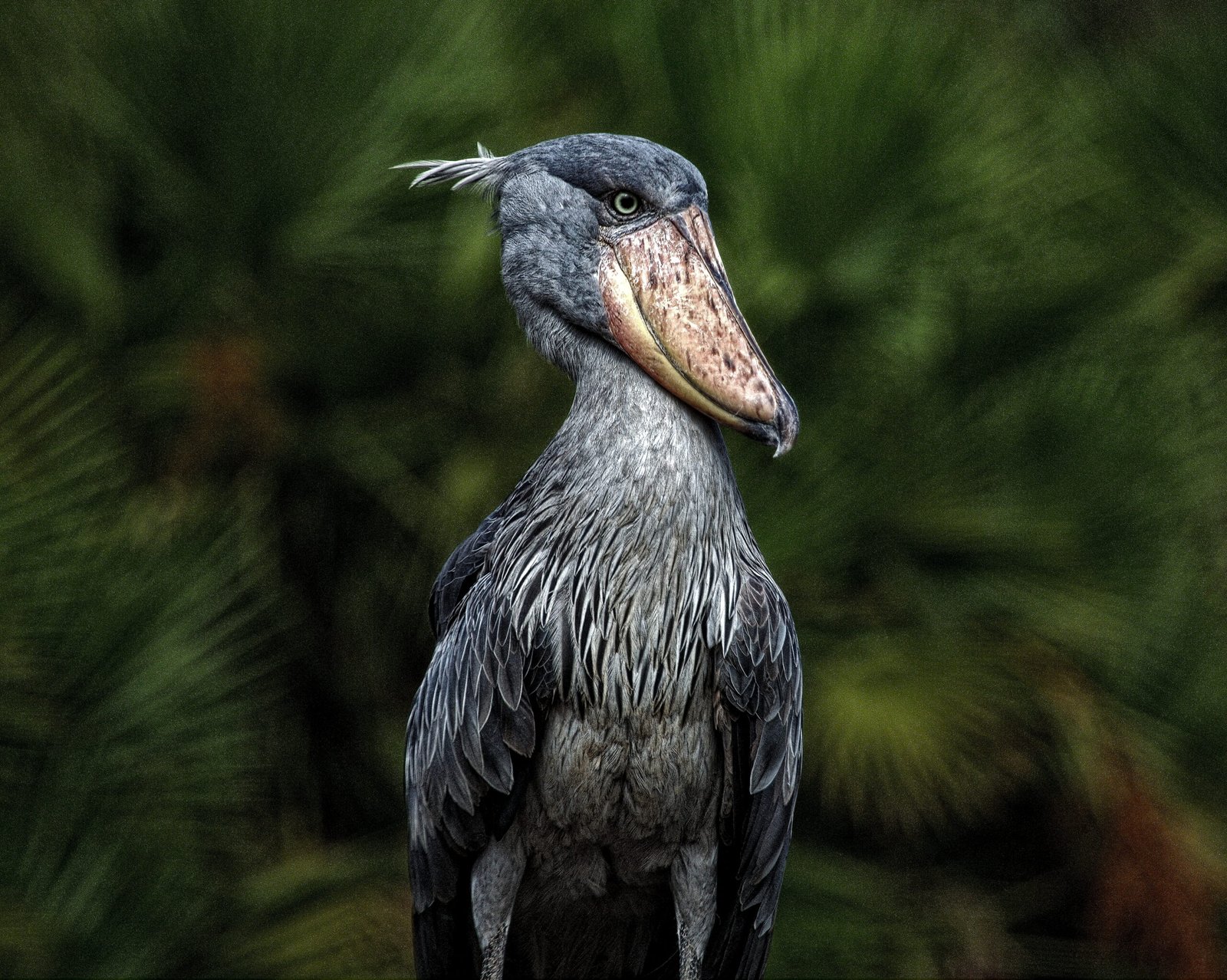Best Time To Witness the Serengeti National Park Wildebeest Migration.
In Tanzania’s Serengeti National Park, the great wildebeest migration season may begin and conclude between June and September.
At certain times of the year, nature prompts the angulates of the Serengeti National Park to search for richer pastures in Kenya’s Masai Mara National Reserve, and vice versa.
When the grass in one location runs out, zebras often initiate Tanzania’s great wildebeest migration, which is then followed by wildebeest, gazelles, and other antelopes.
The big wildebeest migration in Tanzania often starts in Ndutu, in the Ngorongoro caldera region, and ends in Kenya’s Masai Mara National Reserve. Lions, cheetahs, hyenas, giant Nile crocodiles, leopards, and other creatures that watch out for stragglers who are unable to cross the rivers are among the skimmers on this dangerous journey.
Because of the unpredictable rain patterns brought on by global warming, it can occasionally be difficult to forecast when the big wildebeest migration will begin. A tiny drop of rain might cause the wildebeest to migrate.
Generally speaking, going to Tanzania’s Serengeti National Park is a year-round safari experience. To appreciate your trip, all you need to do is have an open mind.
What Takes Place Between January and March During the Great Wildebeest Migration
Since there is plenty of grass for them to live on, numerous babies are born during this season. Herds of thousands of wildebeest and other herbivores are where many calves experience life for the first time. There is a lot of grass to eat because the rains are heavier during this time of year.
They grow up to compete with the millions of adults for the grass, which makes some people start seeking elsewhere. Pregnant herbivores frequently congregate around Lake Ndutu and Lake Masek. To avoid being eaten by predators, the babies blend in with the long grass.
Seasons in the Serengeti National Park from April to May | Serengeti Wildebeest Migration
The herbivores’ food source decreases as the rains stop, necessitating the search for alternative feeding places as the number of wild animals rises. Before continuing on to the Masai Mara National Reserve in Kenya, some people could decide to make a stopover at the Seronera area.
Tanzania’s Serengeti National Park hosts the Great Wildebeest Migration from May to July.
A vast number of gazelles, zebras, and wildebeests cross the Grumeti River. There is a population of large Nile crocodiles in the River Grumeti that has the chance to capture some bewildered prey, as well as exhausted and feeble travelers. Here, ravenous predators also take advantage of the opportunity to choose the day’s best food. For the majority of Tanzania’s predators, this is their festival.
This is the ideal spot for photographers to capture the greatest moments of survival for the fittest on a Tanzanian safari in Serengeti National Park.
Season of the Great Wildebeest Migration, July to September
Most visitors find this to be the most exciting time of year because pilgrims from Tanzania’s Serengeti National Park come to Kenya to cross the Masai Mara River. The enormous crocodiles in the Mara River present the angulates with still another challenge. In order to continue feeding, raptors such as lions, leopards, hyenas, and jackals also wait for them.
The majority of film teams and photographers take advantage of the chance to document the event in this gory location, which is often the high point of the Great Migration. The conflict at the Kongatende crossing demonstrates how valuable life is to every living person. Every impala, zebra, gazelle, and wildebeest is in survival of the fittest mode.
Season of the Great Wildebeest Migration, October to November | Serengeti Wildebeest Migration
Even though the majority of the big migration period is already nearing its conclusion, there are still opportunities to see the bewildered or late arrivals, wildebeests and gazelles, crossing the Mara River into the Masai Mara, albeit in extremely tiny numbers.
Since the wildebeest and other ungulates are now inhabitants of the Masai Mara National Reserve, where they graze on the lush vegetation till the end of the season, the Tanzanian side may be able to forget about them for a while.
The Great Wildebeest Migration’s December Season | Serengeti Wildebeest Migration
As they return to Tanzania, this is often the peak of the great wildebeest migration. This time frame often lasts into the calving season. The drama may be reduced. They can be observed grazing in Lobo, the Central Serengeti, or near Kogatende as this wildebeest event draws to a conclusion.
Take note
Depending on the year-round climate, wildlife safari activities in the Serengeti National Reserve may change during all of the aforementioned seasons. Due to occasional modifications, this is not the definitive flow of the Great Wilderness Migration. This is due to the fact that it is spontaneous.
Rainfall patterns are one of the primary factors influencing this global natural marvel. A major factor in the big migration is whether or not there is grass at a particular location along their route. They are driven to wander in search of better grazing grounds that can sustain over a million wildebeest and to slake their thirst. Other than nature, no human influences or teachers have orchestrated their movements.
How to Travel by Road to Tanzania’s Serengeti National Park
by air.
How Much Does a Safari in the Serengeti National Park Cost?
Several variables that comprise the general elements of an African trip package determine the final cost of a safari to the Serengeti National Reserve. The whole package’s contents will determine how much you should pay for your African trip.
You should be aware of how many days you are prepared to take a vacation in Africa. This has a significant impact on the overall trip package you select.
The park entrance fee is one of the fixed safari costs that affects all budgets. This funding supports Tanzania’s conservation fund, park upkeep, ranger guide fees, and other park-related costs.
The entire cost is mostly determined by your preferences for activities in Serengeti National Park. The cost of a safari varies depending on your preferences, including taking pictures of the safari, recording animals in the park, birdwatching in the Serengeti, and much more. These could be more expensive than typical tourist excursions.
Another thing to think about is where you will stay during your safari evenings. To name a few, the vehicle to be used during game drives, the number of persons traveling, and the number of days spent in the reserve.
There are three different types of safari packages available in the Serengeti National Park: luxury, midrange, and modest. Selecting the perfect package spares you the headache of not having enough money to cover your safari expenses.
The Best Time to See the Migration of Wildebeests in the Serengeti National Park
Choosing the appropriate time for your safari might significantly increase the overall cost of your Serengeti National Park safari package. The lodges are unable to provide you with a discounted rate if you select the busiest times of year, which are June through September and December through January.
Safari charges the entire price, even for individuals who travel as tour operators, who typically receive discounts, particularly during the shoulder season. Safari costs are a little more expensive overall than during the off-season. All of this is explained by the large number of visitors and their strong demand for lodging.
Many travelers who travel to Africa for a safari vacation are prepared to spend even more simply to be included in this journey. Being among the fortunate tourists who get to see the Wilderness migration is an incredible once-in-a-lifetime opportunity.
You must prepare ahead and discuss your itinerary with your tour operator to understand all the specifics that are included or excluded if this natural marvel is on your bucket list.
Making reservations for lodging during your time in the Serengeti National Park helps you avoid constantly switching between lodges in quest of a place, especially during busy times. Make sure you won’t be hampered by a lack of space because there is no cap on the number of individuals who may remain at the park. During the busiest time of year, the Serengeti’s lodges are typically completely booked.
The likelihood of getting placed on a waitlist is significant for anybody hoping to make last-minute reservations for lodging in Serengeti National Park. There are a few options available, even when it comes to selecting the accommodation you want to stay in during your park nights.
It might be disheartening when lodges put you on a waitlist but are unsure of the number of people who will arrive. You may do this ahead of time if you have a preferred Serengeti lodge where you would want to spend the night.
What to Bring to the Serengeti National Park for a Safari
You may avoid hauling suitcases that could be quite challenging to keep an eye on while on your safari by packing light yet appropriately for any vacation. Having too much baggage might also limit the amount of room in the car, especially if you are traveling with others.
You might occasionally have to pack and unpack if you’re near restrooms or lodging facilities. Going through your baggage repeatedly to find what you want to use while on safari is tiresome.
Without rollers, pack in a duffel bag.
A safari tent that folds up. It’s a wise choice to wear a hat in the outdoors to shield your hair from buzzing insects. You should also cover your head because the tracks are dusty.
Place in cubes.
Packing cubes that you can easily repackage can save time if you need to go through a checkup.
Safari clothing. Bringing convertible safari clothing in eco-friendly hues enhances the experience. On chilly early-morning game drives, you can wear trousers; when it gets too hot, you can switch to shorts. Bring safari clothing that you can wear comfortably on dusty roads, such as khaki and tan.
Repellant for insects
to smear stinging insects over the body and repel them.
A fantastic lens for a camera, especially for photographers and people who want to take amazing pictures of their safari trip.
A first aid pack for unexpected situations when on safari.
Just in case you need it, some hard currency to utilize for transactions or personal expenditures.
A pair of binoculars to see creatures that are far away more clearly.
If you ever get the chance to go outside, you should wear safari boots to protect your feet from creepers or exotic insects. Without an armed ranger guide, this is not advised.
Toiletries, in case you have delicate skin or your lodge does not supply these.
If you need some aeration, especially after a hard day in the field, you can change into flip flops.
Wearing sunscreen will protect your skin if you have to stand in the pool in the sun.
To shield your eyes from the scorching heat, use sunglasses.
At the resorts that offer pool service, guests can wear swimming costumes.
Just in case there are bugs at your resort, use insect repellent.
A flashlight for useift solar power runs short.


